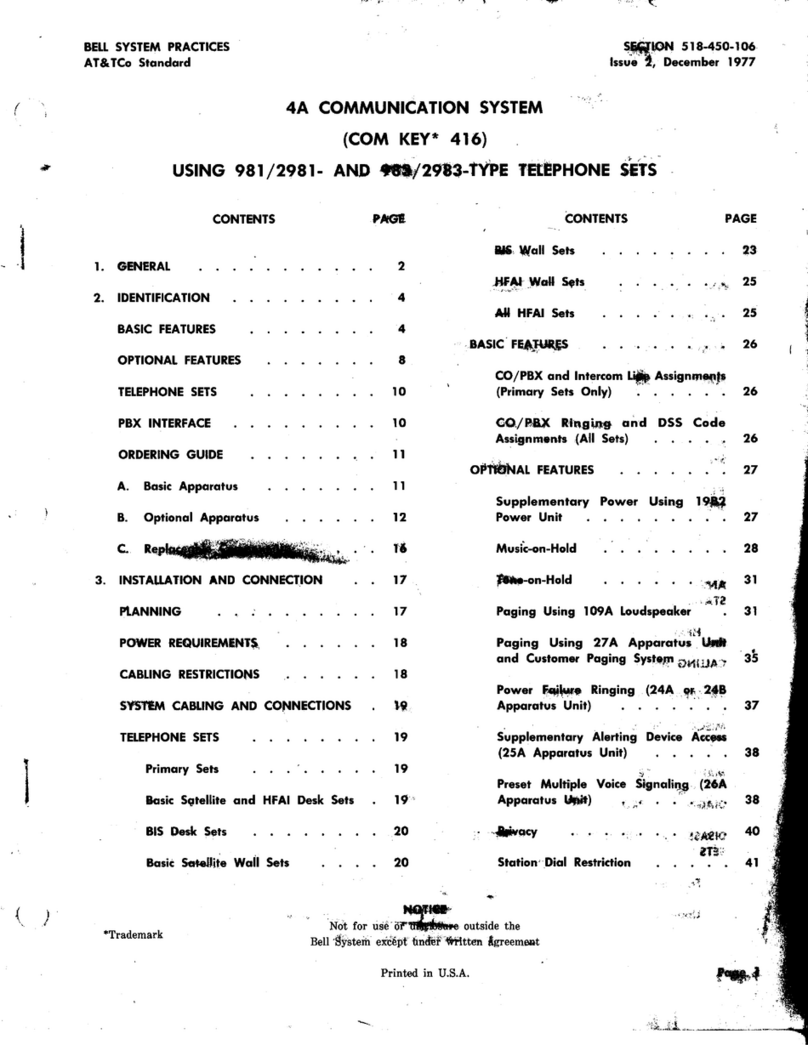
SECTION
518-450-1
06
system includes five types of telephones:
(1)
primary sets,
(2)
basic satellite desk sets,
(3)
basic
satellite wall sets,
(4)
satellite sets with built-in
speakerphone (BIS), and
(5)
satellite sets with
hands-free answer
on
intercom (HFAI). Each
primary set contains the control circuitry for two
CO/PBX lines and one intercom path and the
power circuitry to serve itself and some combination
of
up
to seven satellite sets. The addition of a
second primary set doubles the capacity of the
system; up to seven more satellite sets can
be
connected, with each station in the system now
served
by
up to four CO/PBX lines and two intercom
paths. The satellite sets provide the same basic
services as the primary sets,
but
they
do
not
contain control and power circuits.
Caution
1:
The
4A
System
is
designed
to
operate
on
CO/PBX
loops
of
20
milliamperes
or
greater.
Caution
2:
The
4A
System
is
not
intended
for
installations
where
off-premises
extensions
are
required.
1.04 Because the control and power circuitry of
the
4A
System is contained in the primary
station sets, there is
no
need for separately mounted
key service units such as most key systems require.
The only equipment required in addition to the
telephone sets are interconnecting cables, blocks,
adapters, and small externally mounted units for
some optional features. Systems with many optional
features may require an externally mounted power
unit.
1.05 Each
4A
station can
be
programmed by the
customer to ring
on
any combination of the
common CO/PBX lines. All stations have access
to all common lines in the system; therefore, any
set can
be
assigned as the
attendant
station, if
one is required. Each station also has direct access
to the ten intercom codes.
1.06
All
4A
telephone sets are available with
either
rotary
or TOUCH-TONE® dialing.
The primary set is available only in a desk-type
model, but the basic satellite sets can
be
ordered
in both desk and wall configurations. The BIS
and HFAI sets are convertible from desk to wall
mounting
by
means of a kit of
parts
. There
are
a total of ten telephone set codes
in
the 980-series
(Table
A)
. Figures 1 through 5 illustrate typical
sets.
Page 4
1.07 The
4A
System derives its ac power from a
standard
117-volt 60-Hz source. The system
components
are
protected by a self-resetting thermal
cutout in the power supply of the primary station,
making separate fusing unnecessary. The
19B4
power unit, used when supplementary
de
power is
required, has both input and output fusing.
1.08 While the 980-series telephones provide more
optional features
than
the
830
series
(MD)
used with the earlier
4A
System (Section
518-450-105),
the two series are compatible and interchangeable.
They can coexist in the same system and 980-series
sets can
be
used to replace 830-series sets in
existing installations. However, if supplementary
power is required, the primary sets must
be
from
the
980
series.
Note:
In a mixed system, optional code
busy direct station selection (DSS) keys can
only give busy
indications
for
980-series
telephones.
1.09 Certain components and apparatus used with
the
4A
System have been rated
MD
and
replaced
by
new units. These units are listed in
Table
B.
Throughout the
rest
of this practice, all
references will
be
to the
current
versions of the
units,
unless
the procedures applying to the
MD
unit are different in any way; in the
latter
case,
both units will
be
given separate coverage.
1.10 Schematics
of
the telephone sets and apparatus
units of the
4A
System
are
contained in
SD-69856-01.
The
schematic
of
the
1A
transmitter-receiver (built-in speakerphone module)
is in SD-69800-01.
1.11 For additional information
on
the following
subjects, refer to the documents listed:
4A
Speakerphone-Section
512-700-100
33C
Voice
Coupler-Section
463-341-102
Adjunct Repertory
Dials-Section
501-164-201
KS-16301117
Relay-Section
463-110-100
KS-16626112 Relay
Set-Section
463-120-100
19B4
Power
Unit-Section
167-440-201
Wall-Mounting Fasteners-Section
080-720-105




























